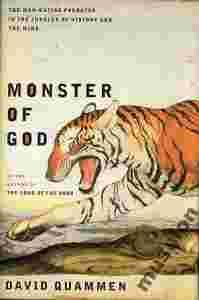|
David Quammen
Monster of God
The Man-Eating Predator in the Jungles of History and the Mind
New York 2003
Stron 515, format: 16x24
THE NEAR PRESENCE OF BIG PREDATORS —
dangerous, flesh-eating beasts—has been a fearful reality throughout human history. Ever since sabertooth cats shared the African landscape with early hominids, our sense of ourselves has been partly defined by the fact that we too, sometimes, fell prey. We could be killed and consumed by this or that ferocious creature—a lion, a tiger, a leopard, a croco¬dile, a shark, a giant lizard (on the island of Komodo), or a bear. We could be turned into meat. Such predators, through their occasional acts of man-eating, reminded us of what we are: mortal beings representing an intermediate link in a food chain. They bound us within the natural world. They denied us the illusion that we are sacrosanct. They enlivened our imaginations with scenarios of horrific, mortifying death.
We loved them and hated them for it. We feared them, detested them, and elevated them to iconic status—godly tigers, kingly lions, bear mothers, totemic crocodiles. And then, with improvements in human weaponry, increases in human population, and the inexorable human destruction of natural habitats, we began to eradicate them. Around the planet today, big predators are in most places either gone or endangered. Under current trends, they can't last much longer. Within two centuries, we may be rid of them altogether. David Quammen's new book asks the question: What then?
Monster of God is an ambitious journey through time and landscape, through science and literature and myth, to explore the nature of big predators and the variety of human atti¬tudes toward them. It's an intellectual travelogue spanning continents and disciplines—from Romania to Australia, from ecology to art history, and from Beowulf to Hollywood. In search of human voices as well as formidable beasts, Quammen visited and revisited four remote landscapes, little-known places where rural people still lead perilous lives in propin¬quity to one or another species of big predator. His book carries us along on those travels—up to high meadows in the Carpathian Mountains of Romania, where the brown bear coexists uneasily with cheese-making shepherds; to an Abo¬riginal community in northern Australia, where the saltwater
crocodile is venerated as an ancestor; to the snowbound Bikin River valley in the mountainous Russian Far East, where the Siberian tiger competes with native trappers of the Udege tribe for a limited supply of deer and boar; and to the Gir forest of western India, last refuge of the Asiatic lion, where stock-herd¬ing people known as Maldharis graze their buffaloes in the presence of the great cats. It also takes us into the background of ecological thinking on certain crucial concepts, such as food chains, the pyramid of numbers, and keystone species.
Monster of God is a book of human characters and human concerns, of history and politics, as well as a bestiary of preda¬tors. How did the rise and fall of Nicolae Ceaugescu, and that dictator's fatuous self-image as a mighty hunter, affect the extraordinary abundance of bears in Romania's mountains? How did the territorial sovereignty of a minor Indian prince, the Nawab of Junagadh, play a critical role in saving the Asiatic lion from extinction ? Who is the preeminent Aboriginal expert, in northern Australia, on traditional methods of harpooning a crocodile? How cold can a person get, along the upper Bikin River, aboard a speeding snowmobile driven by a manic Russian biologist? Will a little vodka help to cut the chill?
Behind all Quammen's journeying are some serious questions about the past, present, and future of big predators. But there are no ultimate answers—only decent people facing hard dilemmas, magisterial animals sorely threatened, a message of warning, and some wonderful stories.
CONTENTS
THE FOOD CHAIN OF POWER AND GLORY I
ONCE THERE WERE LIONS 17
THE MESKRAT CONUNDRUM 77
LEVIATHAN WITH A HOOK 125
SHADOW OF THE NINE-TOED BEAR 209
THE TEETH AND THE MEAT 301
PERESTROIKA ,3,31
SCIENCE FICTION ENDING 399
Source Notes 439
Bibliography 451
Acknowledgments 481
Index 487
Advance Praise for MONSTER OFGOD
"Erudite, witty, and utterly fascinating, David Quammen's exegesis of the life and habits of four parlous predators—creatures that can and do consume humans—sets a new standard in nature writing. Here we have biology, history, sociology, politics, and behaviorism combined in as full and rich a portrait of these animals and their envi¬ronment as has ever been produced."
—T. Coraghessan Boyle, author of Drop City
"David Quammen has given us a frontline report from the longest war in human history—the struggle against man-eating carnivores—and shows how much we have lost by winning it. Monster ofGod is an adven¬ture to read—and a sobering reminder of our place in the natural world."
—Barbara Ehrenreich, author of Nickel and Dimed
"This may be the most clear-headed account in human history of relations with our colleagues at the top end of the food chain. It's just what we need if we're somehow to muster the humility necessary to allow these fellow creatures to survive the century." —Bill McKibben, author of Enough: Staying Human in an Engineered Age
'''Monster of God confirms that David Quammen is one of the most remarkable writers working in the English language. His prose daz¬zles—one keeps turning the pages simply to delight in the way he assembles sentences—but what he says is even more compelling than how he says it. This is an important book. It is a meditation on hubris and its perils, framed as a report on some fearsome and astonishing creatures. As Quammen explains, 'For as long as Homo sapiens has been sapient . . . alpha predators have kept us acutely aware of our membership within the natural world. They've done it by reminding us that to them we're just another flavor of meat.'" —Jon Krakauer, author of Into Thin Air
|
|
 |

